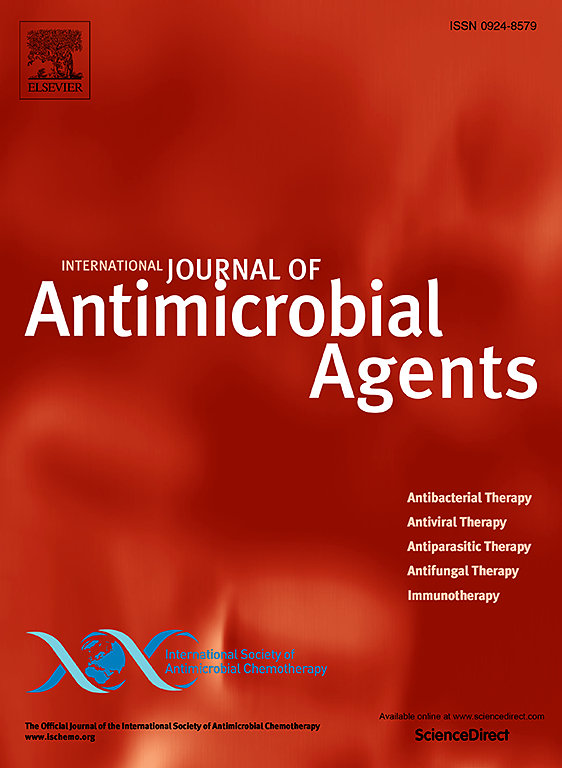Unveiling the clonal dynamics and transmission mechanism of carbapenem-resistant klebsiella pneumoniae in the ICU environment
IF 4.6
2区 医学
Q1 INFECTIOUS DISEASES
International Journal of Antimicrobial Agents
Pub Date : 2025-05-07
DOI:10.1016/j.ijantimicag.2025.107532
引用次数: 0
Abstract
CRKP infections are a significant public health threat due to their high mortality and limited treatment options. This study aimed to investigate CRKP colonization and clonal dissemination mechanism in an ICU. From August 2019 to December 2019, 8668 samples were collected from patients and the ICU environment for CRKP screening. Positive samples underwent antimicrobial susceptibility testing, whole-genome sequencing, and molecular epidemiological analysis. Disinfectant sensitivity and ultraviolet (UV) resistance experiments were conducted to evaluate clonal persistence. The overall CRKP positive rate was 4.85% (420/8668), with higher rates in patients (14.77%, 247/1672) compared to environmental surfaces (2.47%, 173/6996). Intestinal and ventilator-related surfaces were identified as high-risk colonization sites. Molecular analysis revealed six sequence types, with ST11-KL64 (44.05%, 185/420) and ST15-KL112 (24.05%, 101/420) as dominant clones, both exhibiting elevated virulence. Notably, the emerging ST15-KL112 clone demonstrated enhanced resistance to disinfectants including chlorhexidine (MIC 8 mg/L) and benzalkonium chloride (32 mg/L). While most isolates produced KPC-2 (72.86%), OXA-232 prevalence (25.23%) exceeded prior reports. Crucially, ST11 strains survived standard UV disinfection (60-second exposure) at rates 1.3- to 5-fold higher than other clones (p < 0.01). Our findings highlight the critical role of disinfectant resistance in sustaining CRKP transmission. To mitigate outbreaks, we advocate for disinfectant rotation protocols targeting disinfectant-resistant clones and prolonged UV exposure times in ICUs. The persistence of resistant CRKP clones in the ICU environment, particularly their high tolerance to disinfectants, highlights the urgent need for enhanced infection control strategies, including tailored disinfection protocols and surveillance programs.
揭示耐碳青霉烯肺炎克雷伯菌在ICU环境中的克隆动力学和传播机制。
CRKP感染由于其高死亡率和有限的治疗选择,是一个重大的公共卫生威胁。本研究旨在探讨CRKP在ICU中的定殖和克隆传播机制。2019年8月至2019年12月,从患者和ICU环境中采集8668份样本进行CRKP筛查。阳性样本进行了抗菌药敏试验、全基因组测序和分子流行病学分析。通过对消毒剂的敏感性和对紫外线(UV)的抗性实验来评价克隆持久性。CRKP总阳性率为4.85%(420/8668),患者阳性率为14.77%(247/1672)高于环境表面阳性率2.47%(173/6996)。肠道和呼吸机相关表面被确定为高危定植点。分子分析显示6种序列类型,ST11-KL64(44.05%, 185/420)和ST15-KL112(24.05%, 101/420)为优势克隆,均表现出较高的毒力。值得注意的是,新出现的ST15-KL112克隆对氯己定(MIC为8 mg/L)和苯扎氯铵(32 mg/L)等消毒剂的耐药性增强。虽然大多数分离株产生KPC-2(72.86%),但OXA-232的患病率(25.23%)超过了先前的报道。至关重要的是,ST11菌株在标准紫外线消毒(暴露60秒)下的存活率比其他克隆高1.3至5倍(p0.01)。我们的研究结果强调了消毒剂耐药性在维持CRKP传播中的关键作用。为了减轻疫情,我们提倡针对抗消毒剂克隆和延长icu紫外线暴露时间的消毒剂轮换方案。耐药CRKP克隆在ICU环境中的持续存在,特别是它们对消毒剂的高耐受性,突出表明迫切需要加强感染控制策略,包括量身定制的消毒方案和监测规划。
本文章由计算机程序翻译,如有差异,请以英文原文为准。
求助全文
约1分钟内获得全文
求助全文
来源期刊
CiteScore
21.60
自引率
0.90%
发文量
176
审稿时长
36 days
期刊介绍:
The International Journal of Antimicrobial Agents is a peer-reviewed publication offering comprehensive and current reference information on the physical, pharmacological, in vitro, and clinical properties of individual antimicrobial agents, covering antiviral, antiparasitic, antibacterial, and antifungal agents. The journal not only communicates new trends and developments through authoritative review articles but also addresses the critical issue of antimicrobial resistance, both in hospital and community settings. Published content includes solicited reviews by leading experts and high-quality original research papers in the specified fields.

 求助内容:
求助内容: 应助结果提醒方式:
应助结果提醒方式:


